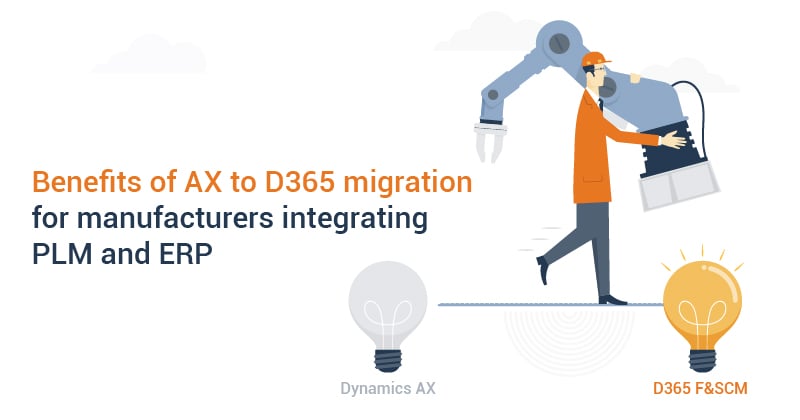A manufacturing company will migrate from Dynamics AX to Dynamics 365 Finance and Supply Chain Management (F&SCM) when the shift fits the business's end-to-end financial management and long-term strategy.
With Microsoft officially ending its mainstream support for Dynamics AX 2009/2012, you may be looking to upgrade to the latest ERP version. Migrating to Dynamics 365 F&SCM guarantees access to the functional enhancement per Microsoft's update policy.
However, an ERP upgrade isn't as simple, and there are multiple factors to remember for a successful transition from AX to D365 F&SCM.
With nearly two decades of experience helping manufacturing companies with solutions on Dynamics 365, we know the business growth a company experiences after migrating from Dynamics AX to Dynamics 365 F&SCM.
This article shares how you can migrate your PLM-ERP integration if you plan to upgrade or are currently upgrading to Dynamics 365 F&SCM from Dynamics AX.
What should manufacturers consider while migrating from AX to D365 F&SCM?
While planning the upgrade from AX to Dynamics 365 F&SCM is a great decision, it is not a straightforward job, and you must consider several factors.
Upgrading your ERP entails migrating all your systems and plug-in solutions currently in use with Dynamics AX. One crucial element you must update would be your PLM integration with Dynamics AX, which must be updated to work seamlessly with Dynamics 365 F&SCM.
Here are some points to keep in mind when migrating your PLM-ERP integration from Dynamics AX to Dynamics 365 F&SCM:
- A new component – Engineering Change Management (ECM), is added for product control and releases.
- The new components must align with the PLM system and the ECM environment.
- Data will be moving from an on-premises environment to a cloud-hosted environment.
- Data will be stored and transferred in ECM instead of Product Engineering (PE).
- Make sure the engineering and operational data is secure.
- End-users must be trained in the new nomenclature and navigation of D365 F&SCM.
Below, we explain how you can migrate your PLM-ERP integration when upgrading from Dynamics AX to Dynamics 365 F&SCM.
|
Related reading: Benefits of Migrating from AX to D365 F&SCM for PLM-ERP Integration |
How do you migrate your PLM-ERP integration while upgrading Dynamics AX to Dynamics 365 F&SCM?
1. Pre-migration preparation
Carry out a needs assessment to understand your current PLM and ERP requirements. Identify the data, processes, and customizations that must be integrated into Dynamics 365 F&SCM.
If you do not have a PLM system, select one that integrates well with Dynamics 365 F&SCM. Popular options include Siemens Teamcenter, PTC Windchill, or Autodesk Fusion Lifecycle.
If you already have a PLM system, ensure that you carry out the necessary updates before planning for integration.
2. Data analysis and cleanup
Conduct a data inventory and identify all data sources within Dynamics AX and the PLM system. This includes product data, bill of materials (BOM), engineering change orders (ECO), and more.
Sort your data to ensure consistency, accuracy, and integrity by cleaning and validating the data. Resolve discrepancies and remove any duplicate records and outdated information.
3. Choose the PLM-ERP integration strategy
Understand the integration in your Dynamics AX system. Evaluate existing extensions and integrations and assess their compatibility with D365 F&SCM.
Choose the integration method and decide whether to build or buy the PLM-ERP integration. You can opt for standard connectors, middleware solutions, or design customized software for integrating PLM and ERP systems.
4. Integrate PLM with Dynamics 365 F&SCM
Define data mapping rules to ensure that data from the PLM system aligns with the data structure of Dynamics 365 F&SCM.
Configure and set up Dynamics 365 F&SCM to accommodate PLM data, such as product information, BOMs, and ECO workflows. Based on your business needs, decide whether you need real-time or batch data synchronization between PLM and Dynamics 365.
5. Test the integration
Test the integration components individually to ensure they work correctly via unit testing. Verify data flows smoothly and accurately between PLM and Dynamics 365. Check for any synchronization issues or errors.
Carry out User Acceptance Testing (UAT), which involves end-users validating that the integrated system meets the operational requirements.
After the testing, you can do the training, go live, and monitor the PLM integration with Dynamics 365 F&SCM for any performance optimizations.
Different migration scenarios applicable with AX to D365 F&SCM upgrade
Your integration migration strategy will differ depending on which PLM-ERP integration solution you use or whether you have an integration in place. Here are the three migration scenarios to expect depending on your business case.
Migration Scenario 1: Migrating from Product Engineering in AX to Engineering Change Management in D365 F&SCM
This is applicable for manufacturing companies using the change management module in Dynamics AX called Product Engineering (PE) and have their PLM system integrated with AX.
When moving to Dynamics F&SCM, you must migrate from PE to Engineering Change Management (ECM).
The migration will involve an upgrade in the ERP system, in all the data from PE to ECM, and in the PLM integration, which will be moved to Dynamics 365 F&SCM instead of AX.
Most of our existing customers using the PLM integration on Dynamics AX have deployed PE; therefore, the migration will be straightforward. Since PE (now ECM in Dynamics 365 F&SCM) is a solution we designed and developed, we can assist you with the migration process.
Migration Scenario 2: Migrating from PLM integration with AX to PLM integration with D365 F&SCM
This scenario applies to companies using Dynamics AX as their ERP and have tailormade or customized a PLM-ERP integration solution to connect their PLM system with AX.
The migration would include moving to Dynamics 365 F&SCM and activating the ECM module, as ECM is responsible for creating engineering-controlled products and handles version management.
After the ERP upgrade, you can deploy a PLM integration with Dynamics 365 F&SCM. A PLM-ERP integration embedded in the Dynamics 365 F&SCM environment can be beneficial in such cases. We offer the same, as our PLM-ERP integration follows the D365 business logic, offers a seamless user experience, and eases maintenance.
Migration Scenario 3: Migrating from non-integrated PLM-AX systems to integrated PLM-D365 F&SCM
While the above two scenarios talk about migrating with an existing PLM-ERP integration solution, there could be cases where manufacturers do not have an integration at all. This could mean you are using Dynamics AX and have a PLM system, but there is no integration between the PLM and Dynamics AX.
In such cases, after the ERP migration, you must implement a PLM-ERP integration solution for Dynamics 365 F&SCM with ECM. With no experience in integration, there are a few things you must take care of, and you could learn how to prepare your business before PLM-ERP integration.
How can we help you migrate your PLM-ERP integration to Dynamics 365 F&SCM?
With a global partner network and part of the Microsoft Inner Circle, we can help you migrate your PLM-ERP integration from AX to D365 F&SCM.
Our deep expertise has helped us define how data is mapped from PLM to Dynamics 365 F&SCM. We have the knowledge of the data type, format, and volume, that must be imported, saving time in defining the data.
Here are a few helpful links so you can understand how we can help you:
- Why data migration is crucial for PLM-ERP integration for D365 F&SCM
- How a preconfigured PLM integration for Dynamics 365 offers quick value
- How do we implement PLM integration for Dynamics 365 F&SCM
Want to get started with PLM-ERP integration for your business?
If you are looking for an intuitive PLM-ERP integration solution with low coding effort and a quick implementation process, our solution is worth exploring.
We provide out-of-the-box PLM integrations for Siemens Teamcenter and PTC Windchill and a configurable PLM integration framework for other PLM, PDM, or CAD systems.
You can learn more about our solution in this factsheet. Contact us if you want to begin discussing your journey toward PLM integration for Dynamics 365 F&SCM.


